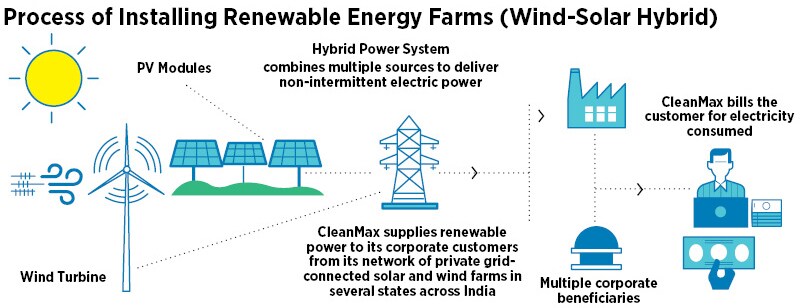
How Kuldeep Jain's CleanMax is greening India Inc
By providing renewable energy to corporates, Kuldeep Jain's CleanMax has been helping them meet sustainability goals while growing in size and credibility itself
 Kuldeep Jain, Founder and MD, CleanMax
Image: Neha Mithbawkar for Forbes India
Kuldeep Jain, Founder and MD, CleanMax
Image: Neha Mithbawkar for Forbes India
After working with McKinsey & Company as a global partner, heading energy and corporate finance practices for almost 12 years, Kuldeep Jain, then 36, decided to fulfil his childhood dream of becoming an entrepreneur. But it was not all rosy. In 2011, when Jain founded CleanMax (previously CleanMax Solar), he was clear about his target users and wanted to be a sustainability partner of corporates to help them go green by setting up gas-fired power plants. It was all going according to plan, and Jain even managed to raise money. But over the next 12 months, Jain’s business plan failed, as gas prices doubled following the Fukushima nuclear disaster in Japan in March 2011. “We came to a point where we suddenly had no business plan. I had put in a lot of money and it was also running dry. It was just year one and we failed miserably,” recalls Jain.
However, on the bright side, solar power prices started coming down. In 2012, CleanMax pivoted its business and started setting up solar rooftop plants for companies. Then there was no turning back. The company became a pioneer in the ‘operating expenses (Opex) model’ in India, where the company puts up solar plants— rooftop or otherwise—at its own cost, and sells the power directly to customers. “With the Opex model, onsite solar comes with zero investment and puts the performance risk on us. The client pays only for the energy generated, which is typically 30 to 40 percent cheaper than industrial grid tariffs. By paying per unit, they also avoid taking a risk on the technology, equipment life, or plant generation. The client pays for the energy, and leaves everything else to us,” explains Jain.
At present, the company has more than 200 customers, including leading corporations such as Facebook, Tata Motors, Tata Communications, Grasim, Cipla, United Breweries, MG Motors, Adobe, Cargill Foods, Volvo, Mahindra Group, Sansera and NTT. “Sustainability is a focus area for NTT across the globe,” says Sharad Sanghi, managing director of NTT India. “In India, we have partnered with CleanMax to address the renewable energy requirements for some of our key data centres. CleanMax has rapidly scaled up their supplies, helping us with our investments in wind and solar power. This partnership will play a key role in helping us achieve our ambition of net zero emissions across our operations by 2030.”
 Besides rooftop solutions, CleanMax has developed a network of grid-connected, open access solar and wind farms across India to supply renewable energy to its corporate clients who are looking to achieve 100 percent renewable energy sourcing. In 2019, the company diversified into wind and wind-solar hybrid models. After doing a strategy review, Jain realised that the combination of wind plus solar is much more beneficial to clients than solar alone. The two major requirements of his clients are 100 percent green power and cost saving; 60 percent of the client’s requirements are met with solar, whereas 30 percent of their requirements are met by wind-plus-solar. “This hybrid model has been a big success for us,” says 47-year-old Jain. “Cargill, the US-based global food corporation with a large factory at Davangere, Karnataka, required power round the clock. We arrived at an optimal mix of wind and solar power, to deliver approximately 40 million units of power every year, throughout the year. This wind-solar hybrid farm began generating power in 2019, providing up to 90 percent of the factory’s power requirement.”
Besides rooftop solutions, CleanMax has developed a network of grid-connected, open access solar and wind farms across India to supply renewable energy to its corporate clients who are looking to achieve 100 percent renewable energy sourcing. In 2019, the company diversified into wind and wind-solar hybrid models. After doing a strategy review, Jain realised that the combination of wind plus solar is much more beneficial to clients than solar alone. The two major requirements of his clients are 100 percent green power and cost saving; 60 percent of the client’s requirements are met with solar, whereas 30 percent of their requirements are met by wind-plus-solar. “This hybrid model has been a big success for us,” says 47-year-old Jain. “Cargill, the US-based global food corporation with a large factory at Davangere, Karnataka, required power round the clock. We arrived at an optimal mix of wind and solar power, to deliver approximately 40 million units of power every year, throughout the year. This wind-solar hybrid farm began generating power in 2019, providing up to 90 percent of the factory’s power requirement.”
With renewable energy going mainstream, the industry has seen dynamic growth in the past few years. Corporates in India and across the world are aiming for 100 percent renewable energy, to achieve their sustainability goals and save on costs. CleanMax tapped the market at the right time and became one of Asia’s largest providers of renewable power to corporates. Jain adds, “We’ve even worked for India’s third largest airport, the Kempegowda International Airport, Bengaluru. We worked within significant security restrictions at the airport to install a 504 kilowatts peak (kWp) solar power plant in March 2016, covering approximately 2 acres. Two years later, the airport also procured 13 MW of solar power from CleanMax’s private solar farm in Karnataka.”











